4Front Technologies’ True Pianos Review
In the seemingly never-ending quest for glorious tone, authentic playability, and modest system requirements, many pianists are left disillusioned with many of today’s ITB offerings. Few musicians have either the physical space or the bankroll to actually invest in a baby grand; or even a high-end “Digital Grand”.
Many keyboardists struggle to keep their computers afloat in the sea of multi-gigabyte sample libraries; with each new library promising to deliver finer sound and greater piano realism.
I own a few substantial piano sample libraries, and for the most part, they are all very good. However, they consume a great deal of precious hard drive space, and available system memory. For those who own up-to-date computers housing fast hard drives, and large denominations of blistering-fast RAM, this isn’t as much of a concern . . . ‘ yet’; wait another year or two and maybe the newest sample libraries will be even that much more demanding.
But all is not lost! We can thank God and the good folks at 4Front Technologies for finally making the dream a reality. For the gracious price of only £121.55, or $180 (USD), 4Front’s suite of five modelled pianos is nothing shy of spectacular and splendorous. Furthermore, True Pianos is ‘truly’ multi-platform in that it is available for Windows PC (32 bit & 64 bit), Mac (Intel & PPC), Receptor, and vMachine!
The only “true” competitor to 4Front’s modelling excellence is the illustrious “PianoTeq 4”, which will also be reviewed here on Reviewer’s Revival in the not-too-distant future. Each of these great packages exhibits its own uniqueness and allure. Reviewer’s Revival never deliberately compares one product to another, in an attempt to force a choice between the products. In keeping with that principle, let’s continue focusing on True Pianos at this time.
I always like to find that “something” about a product that causes it stand out; something that puts it ahead of the other race horses, even if only by a nose. In this case, that “something special” is the very conservative system requirements and how ‘lite’ this beautiful-sounding piano suite is on CPU and memory. Now, dear reader, before you glance up at the “back” button thinking that “light on CPU” means “light on sound-quality”, rest assured that nothing could be further from the truth. When 4Front Technologies released True Pianos in January of 2007, it became immediately obvious to the digital-instrument community that this software was “something different”. True Pianos is a highly evolved, digital symbiotic-relationship of sampling, synthesis and physical modelling. Collectively, these attributes work synergistically to reproduce incredible piano realism whilst demanding very little memory and processing power. (Comparatively speaking, that is.) An obvious benefit of 4Front’s technology is the fact that the sound is generated programmatically ‘on the fly’, eliminating disk streaming and hard drive caching.
With five, distinct piano types to choose from, True Pianos is sure to provide the perfect tone for any given project. The good folk at 4Front do not specify which actual piano models are referenced by the five modules, but suffice it to say, each of them is excellent. We’ll delve into each of the five modules a little later.
As a general statement, True Pianos can certainly be considered more than able to replace most nearly any large, hard drive-taxing piano sample library. 4Front’s lead programmer, George Yohng, is highly respected among his peers for spear-heading and developing the audio-engine that powers the “Vienna Symphonic Library”. The specialized sampling technology evidenced in True Pianos is the brain child of Mr. Roel de Wit. I pointedly asked 4Front Technologies some questions about their virtual piano development. Mr. George Yohng and Mr. Roel de Wit replied to my queries with more detail than I was expecting. Most of the information was submitted in confidence, but I’d like to pass on some of the scoop that may be freely shared. “For each TruePianos module we create what I (Roel) call a footprint as a base to start working from, which through mathematically analysis is derived from actual samples. In case of the Amber module we rented a studio with a certain model of grand piano in it and did a sampling session to obtain the raw material we needed to create the footprint required for starting work on the creation of this module. The Amber module has some characteristics of the original sampled piano but doesn't sound like the original instrument if you would do a direct comparison.”
Installation & Setup:
How wonderful to not be inundated with rigorous, time-demanding installation routines. True Pianos’ individual components were all installed and playable within 5 minutes on the 6 year old dual core laptop that I use for reviewing purposes. The installers are each downloadable from the secure customer-area on the 4Front web site. Customers receive login credentials via email once payment has been remitted. If you are one of those chappies who is in the habit of downloading large, multi-gig sample libraries, this will seem like child’s play to you. The whole blessed lot of installers requires just 390 MB (one installer for the core engine, plus the five piano modules). Product authorization finalizes the quick and painless installation process. Simply type or ‘paste’ the authorization details that you received at time of purchase. The user can load up the instrument on a midi track in his/her DAW, or alternatively, launch True Pianos as a fully self-contained standalone application. Tap the conductor’s sheet-stand; ladies and gentlemen, it’s Piano time! Regarding 4Front’s personalized licensing model, I really, really wish that all developers would sit up and take notice. Some anti-piracy and software-licensing mechanisms are wearisome and a real pain-in-the-noodle. Dongles are inconvenient and can be costly to replace. If you’re an iLok user, it will cost $100 to restore your licenses should your dongle get lost, stolen or fail. You can choose to proactively pay iLok.com $30+ a year for their “Zero Downtime” service (excluding the $50 for a new dongle). If a company folds or stops production, then challenge/response protections will fail. If the user has a serious computer failure or migrates to a new system, then licensing can be cumbersome, difficult and may ever require “arm wresting” with the developer or company to obtain new license codes. It is this reviewer’s opinion that companies such as 4Front, SKnote, ToneBoosters, PSP Audioware, and others of their ilk, provide the BEST customer experience.
Visuals and Interface: Clicking anywhere along the top bar, or either side of the interface, allows the user to choose between the “Basic” and “Advanced” screens. The plug-in’s interface fits easily on modern monitors; maybe even ‘too easily’. The GUI measures off at 796px wide by 362px high. On a current high-res monitor, the beauty of this attractive GUI may possibly get overlooked; it would be nice if the interface came with a resizing option. 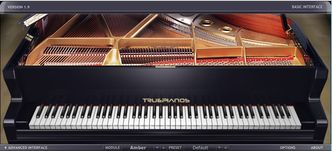
Basic Screen:
When True Pianos first debuted a few years ago, this interface was considered beautiful, and it introduced a new standard of VSTi GUI excellence. For the record, I am still very partial to it. The interface is attractive, functional, and most importantly, it’s blisteringly quick. No lags, no pauses. I suspect that the visual components of this ‘Speedy Gonzalez of pianos’ have been optimized as tightly as the underlying sound engine. 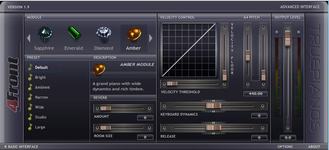
Advanced Screen:
The “Advanced” screen is equally as well designed. Subtle, elegant 3D elements are tastefully placed on this easy-to-read screen. All control labels are clearly seen in clean, white, anti-aliased typeface. The controls respond very smoothly to mouse movements and “shift-click & drag” provides very fine, granular parameter changes. Double-clicking any control automatically resets the control back to its zero or default values. The numeric value of each control is displayed in the control’s accompanying “Value Box”. The user may simply click on any of these and key in a value using the numeric keypad on your computer keyboard.
The “Basic” screen depicts a tres chic, 3D modelled, non-descript grand piano, as seen from the player’s perspective. The piano keys move in real-time as the player strikes the keys on his/her midi keyboard. Effective lighting and shadowing, and slightly rounded edges, all contribute a delicate sense of class and photo-realistic charm. Attention to detail is obvious here – even the piano-lid hinges and hardwood flooring are tastefully and accurately drawn.
Along the bottom of the “Basic” interface are four menu options; Module, Presets, Options and About. The ‘Module’ menu displays the list of five piano modules; the ‘Presets’ menu contains the list of factory presets per module. This list changes dynamically depending on the selected module. The ‘Options’ menu opens an easy-to-navigate window containing only three checkboxes and a vertical, keyboard-dynamics slider. These allow the user to select an increased polyphony, multi-core CPU option, sympathetic resonance and keyboard dynamics. It is important to note that the increased polyphony option will increase the load on your system. This is not an issue likely to be realized using newer computers. Keeping the checkbox cleared still retains excellent sound quality, but eases the strain on older or underpowered systems. The keyboard dynamics slider allows the player to adjust the midi-velocity to best match the player’s midi keyboard and his/her playing style.
Along the top left-most part of this screen you will see the five piano modules listed with gem-stone icons. The naming conventions and icon styles reinforce the “classiness” of this elegant VSTi suite of pianos. As each of the five modules is selected, the preset list dynamically changes. The presets are located directly beneath module panel. To the right of the presets list, you will see the module description area and the ‘Reverb/Room’ panel.
Whenever a piano module is selected, a brief description of that module is displayed in the description box. The various modules are described by 4Front as follows: Atlantis: True Pianos 2.0 technology preview. By my estimation, this is the ‘richest’ sounding module contained in the collection. It also is the most CPU intensive module. 4Front do not make any claims or innuendos that any of their modules are “modelled” after any particular piano model; however, this one sounds convincingly like a Steinway Model D to my ears. I own three different “Steinway” sample libraries, so I’ve become quite keen in recognizing the unmistakable warmth and presence of a Steinway. Then again, maybe it sounds like a Bösendorfer . . . *grin. At any rate, the Atlantis module deeply satisfies with it’s “bouncing”, robust lower register, its full-bodied mids, and the lovely clear, brilliant top end. 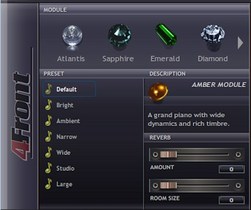
The reverb/room panel facilitates a means of adding reasonably natural-sounding ambience to the signal. The quality of the reverb algorithm is adequate and pleasing enough. The reverb/dry ratio is controlled with the ‘Amount’ slider, and the perceived size of the room is adjusted with the ‘Room Size’ slider located below.
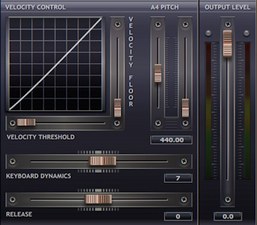
On the left of the advanced screen, the “Velocity Control” panel facilitates advanced manipulation of True Pianos’ midi sensitivity and behaviour. This panel is a grouping of velocity-relevant parameters that strongly influence the ‘realism’ of this magnificent virtual piano suite.
The “Velocity Floor” slider allows you to “bring out” the mellower piano sound of playing a piano softly, at much higher velocity levels as normally would be the case. It can be used to make presets darker as well as to compensate for not-so-perfect MIDI keyboards that don’t let you play well at lower velocities. I have a Roland E-50 which is great for synth and organ playing. Since the E-50 is only a touch-sensitive controller and does not have weighted hammer action, it feels much too “elastic” to be a good piano controller. I found that setting the “Velocity Floor” to a value of -37 dB worked absolute wonders on my piano tracks.
The “Velocity Threshold” slider sets the minimal MIDI input velocity value that True Pianos will react to. This option is especially useful to those with sensitive, non- and semi-weighted keyboards. Moving this slider a bit to the right avoids accidental notes while resting your hands on the MIDI keyboard. Again, with my Roland E-50, this option is a very, very welcome feature. The user-friendliness, and the variance of control that both of these velocity sliders provides, is quickly making True Pianos my absolute favourite virtual piano. The sound is fantastic, and so is the playability. I am impressed – very impressed.
The “Keyboard Dynamics” slider seen here is the same parameter as we already saw on the “Basic” screen. To nutshell, it affects the velocity sensitivity curve, character and many other aspects of the way that True Pianos’ modules will respond and sound. A “Release” slider is provided to accord user-preference over the length of note decay when a key is released on the midi keyboard, while the sustain pedal is up. Collectively, these advanced parameters allow the player to achieve tremendous acoustic piano realism. True Pianos is capable of reproducing startling, “True” piano sound – aka “True Pianos”. To complete the options on the “Advanced” interface, there is a pair of sliders to allow ‘fine tuning’, and a pair of Output Level sliders. The default pitch of True Pianos is A-440, but the pair of Pitch/Tuning sliders are greatly effective for ‘on the fly’ tuning adjustments. This is especially handy when the pianist is performing with other acoustic instruments that may not be perfectly tuned to standard A-440 tuning. The left slider changes the tuning frequency in 1 Hz steps, while the right slider works in 0.01 Hz steps (cents). The volume sliders . . . adjust the output levels. Hmmm, does that last line read redundantly to you? I haven’t infused much witticism into this article; wut, with True Pianos bein’ so spiffy, n’ classy, n’ all.
Sound Quality:
4Front have put concerted, intelligent programming effort into the development of True Piano’s core engine itself, as well as the accompanying piano modules. They have accomplished a very great feat, in this reviewer’s professional opinion. That said, what they have deliberately eschewed away from, is an attempt to include a bevy of DSP effects; with the exception of their very adequate and usable, built-in reverb/room algorithm. Since this piano suite requires such conservative processing and memory amounts, 4Front feel that specialized processing is best left to 3rd party plug-ins. There is plenty of computer “headroom” available for 3rd party effects-processing while using True Pianos. Since True Pianos is a synergistic hybrid of three distinct technologies, it does not suffer from any type of velocity switching failings. It is by far, the most dynamic virtual piano I have played, to date. As I mentioned earlier, the impressive-sounding PianoTeq 4 (Standard) will also be bench-tested and reviewed here on Reviewer’s Revival. Notwithstanding, to this point in time, True Pianos is the Reviewer’s Revival reigning monarch of virtual-piano dynamics and expression. The “Sympathetic Response” is subtle, but having it enabled in the Options Panel does contribute increased realism to the overall sound. As an umbrella statement, the wide-ranging sound quality of True Pianos is excellent. This collection of virtual pianos produces realistic sounds that run the full gamut of piano tone spectrum. I’d go so far as to say that the “Atlantis” module’s sound quality is ‘exquisite’. This module reproduces a powerful, imperial sound quality reminiscent of “Steinway Model D” or “Bösendorfer 290” Grands.
For the producer looking to find a bright, “in your face” rock/pop sound, the “Sapphire” module can be the producer’s best friend. Sapphire ‘cuts’ through a busy pop or rock mix with authority and detailed presence. Those listening for neutral or mellower, jazz-like tones will enjoy the beautiful, emotive notes that are easily massaged out of the “Diamond” module.
Although the “roomy” sound of the “Emerald” module is not suitable for all playing styles and all musical genres, it is this reviewer’s opinion that it exhibits the finest low register, out of the collection. Emerald is also very well suited to three or four piece jazz ensembles; in particular, the ‘Classic’ preset is very evenly-balanced across all 7 octaves and oozes comforting, warm tones.
The default module, “Amber”, reminds me somewhat of a "Yamaha C7". It’s features full-bodied, resonant sound quality that tends to be a tad bright. This is not necessarily a bad thing; especially in a busy mix. Judicious adjustment of the “Keyboard Dynamics” slider will bring out a more mellow character, and increasing the “Velocity Floor” will vastly improve its tenure toward softer, lounge-piano playing styles. To my ears, the “Amber” module’s “Studio” preset offered a nice, well-balanced tone in combination with realistic-sounding hammer strikes. I felt that it was a very pleasant, “intimate” piano sound well-suited to Gospel, Chicago-blues or Jazz-combo styles.
Each of the five modules produces clear, appreciably realistic piano sound. Many present-day pianists have become accustomed to playing midi keyboards, accessing carefully recorded sample libraries of specific instruments. True Pianos requires a slight change of mindset. The modules are a synergy of digital samples, synthesis, and VSTi modeling. These modules are not intended to sound ‘exactly’ like any particular piano model; however, any serious pianist will readily recognize certain tonal qualities as those heard in coveted, famous piano models.
True Pianos is highly responsive and dynamic. Of all the virtual pianos I have ever used, I can honestly report that this delectable collection of finely-crafted, modelled pianos is one of “the most dynamic” I've had the pleasure to experience. Great expression and subtleties of tone are painstakingly coded into this small, unpretentious piano suite.
Stereo Imaging & Depth:
Each of the five modules is pleasingly spacious and dynamic across the stereo field. Both the “Amber” and “Atlantis” modules exhibit the greater degrees of dynamic stereo width. The “Sapphire” module is also very dynamic and wide; perhaps it is the ‘widest’ of the lot. The “Emerald” and “Diamond” modules seem to be the easiest to place and pan in a mix. I would welcome a “width” control as a new feature to be implemented in a future release of True Pianos. For solo piano performance, or when playing in a small combo setting, the dynamic stereo width is absolutely wonderful. Sometimes, however, it is befitting to ‘narrow’ an instrument so that it can be placed in a mix a little easier. In the meantime, there are 3rd party plug-ins that can adjust the width of a stereo instrument, such as: SKnote, XTrim; DDMF, StereooeretS; and SleepyTimeRecords, StereoChannel. 4Front’s built-in reverb module is very good – better than I was expecting from a ‘bundled’ ambience effect. It’s quite deep, and didn't seem to me to be profusely ‘wide’. This built-in reverb is a single algorithm, but it is somewhat of a “Goldilocks”. It’s just right. Please don’t think this is a negative. On the contrary, the reverb sounds as good as many 3rd party plug-ins costing $100 or greater. It has a very pleasant, subtle modulation that greatly enhances piano sounds. Great job, 4Front! Five stars.
CPU Consumption:
True Pianos generally places very conservative demands on both CPU and RAM. The tightly-optimized C++ coding was written by an elite programmer who draws from many years of specialized VSTi programming experience. One quirk that I have noticed about this stellar performer is that the CPU consumption is mildly increased while the “Basic” interface is visible. This CPU increase is not observed while the plug-in is hidden or when the “Advanced” screen is visible. Perhaps this has to do with the auto-refreshing of GUI code with how the graphical elements are drawn on the screen. This is a very minor niggle, and is probably not even discernible on a modern, multi-core computer. Concluding Remarks: In the zealous, competitive market of multi-gigabyte sample libraries, a powerful, lightweight instrument of such quality is to be cherished and well-favored. True Pianos has a finesse and class about it that is befitting a white-tie gala, while still being able to comfortably fit in with a raucous “Little Richard” or “Jerry Lee” rock n’ roll bash-a-thon. This select, finely-crafted collection of five, distinct piano modules is very graciously-priced. Many single-instrument sample libraries cost as much, and perhaps more. True Pianos is a good deal. Honourable Mention: The creators and developers of True Pianos are also the product support team. In other words, each customer is treated with personal care and respect. My interaction with Mr. de Wit and Mr. Yohng has been a very amiable and pleasant experience. These gentlemen have been congenial and courteous while remaining professional and “on top of it.” By the way, TruePianos is discounted 50% for church ministers/worship leaders, also for teachers, students, medical personnel and non-profit good-will workers.
Brother Charles is a freelance writer, Gospel music artist and minister. Charles had been a professional touring musician during the nineties; working primarily as a lead guitarist in the Canadian country music industry. Brother Charles is also involved with music production and quality home recording.
6 Comments
Marsha
4/13/2013 05:02:10 pm
This is a fantastic sounding piano. Your review of this product is very comprehensive.
Reply
C-Belle
4/14/2013 03:36:48 pm
This is an excellent review, in my opinion, of the True Piano VSTi technology. While my own understanding of how it actually works from a technical perspective is rather limited, I am much more interested in the hearing, testing, and comparing the sound and tone production of electronic piano technology such as True Pianos as it relates to the quality of authentic piano realism. As a pianist who is passionate about the enduring and superior quality of an acoustic grand piano tone compared to anything electronic, it takes alot to convince me that advancing piano tone technology has even yet come close to creating a product comparable to it's acoustic counterpart, where tone and adequate resonance is concerned. I have listened to various samples of the True Piano demo, and my conclusion is that I am rather optimistic indeed, that a tool like this affords us a much greater example of an "authentic copy of the real" evidenced here in this unique product. I'm sure many pianists like myself would be glad to try this product without feeling like they were compromising the quality of sound, timbre, and musical texture a real acoustic piano affords. Given all the varied components you had to address in this VSTi, Brother Charles, I felt you gave a rather convincing review to any keyboard player, or pianist out there, that True Pianos is a must have addition to their electronic collection!
Reply
Brother Charles
4/14/2013 06:35:19 pm
Glad you liked it, C-Belle. Thanks very much for the great feedback.
Reply
moritz
12/6/2013 10:02:14 pm
Hi, because of yours and one other review, I tried truepianos. I was very happy with it and decided to buy it. However - I am a student and getting the student discount seems to be impossible. After asking for it 3 times without even getting as much as a reply, I have almost given up on that. However a few days ago, I decided to give it yet another try.
Reply
Criq deKuyper
1/13/2014 03:59:40 pm
I recently delved into the modelled piano technology with a visit to the local music shop and tinkering around with the Roland V-Piano. Then I tuned to both TruePianos and Pianoteq for comparison. While they each have their strong points, I quality/cost of the TruePianos suite is an outstanding investment. I use the Atlantis module for solo, Diamond for Jazz quartet, and Sapphire to cut through in a mix. The CPU overhead is great and the responsiveness using both a Roland MKB-1000m and Yamaha CP-80M controller is great. I personally can't see much room for improvement with future upgrades, but look forward to perhaps more individual note scaling as found in the V-Piano. Then again, for the difference in price between the two, I am happy to stay with the TruePianos package I have now!
Reply
Bro. Charles
4/18/2014 01:37:55 pm
Hi Criq - thanks for the comments, sir. I absolutely agree with your findings regarding TP. I think True Pianos is one of the very finest virtual piano products available!
Reply
Your comment will be posted after it is approved.
Leave a Reply. |
NO SPAM! IK Multimedia Group Buy
FX Pick & Mix Group Buy - up to 16 for the price of 1
Will You Help?Web hosting is getting more and more expensive all the time, and Reviewer's Revival is NOT funded nor supported by any commercial enterprise or business. A donation of any amount is greatly appreciated. Even $2 or $3 for a coffee - every little bit helps. Thanks very much.
Legal BlurbAll of the articles published on Reviewer's Revival are undertaken to be purely objective, impartial reviews. Reviewer's Revival is not owned, funded-by, nor hired by any company or individual. Reviewer's Revival is the sole property of, and solely under the discretion and direction of Brother Charles. |

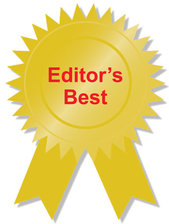
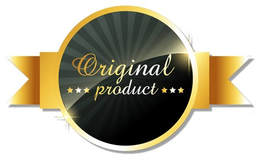

 15% OFF Summer Sale!
15% OFF Summer Sale!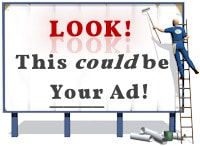
 RSS Feed
RSS Feed

